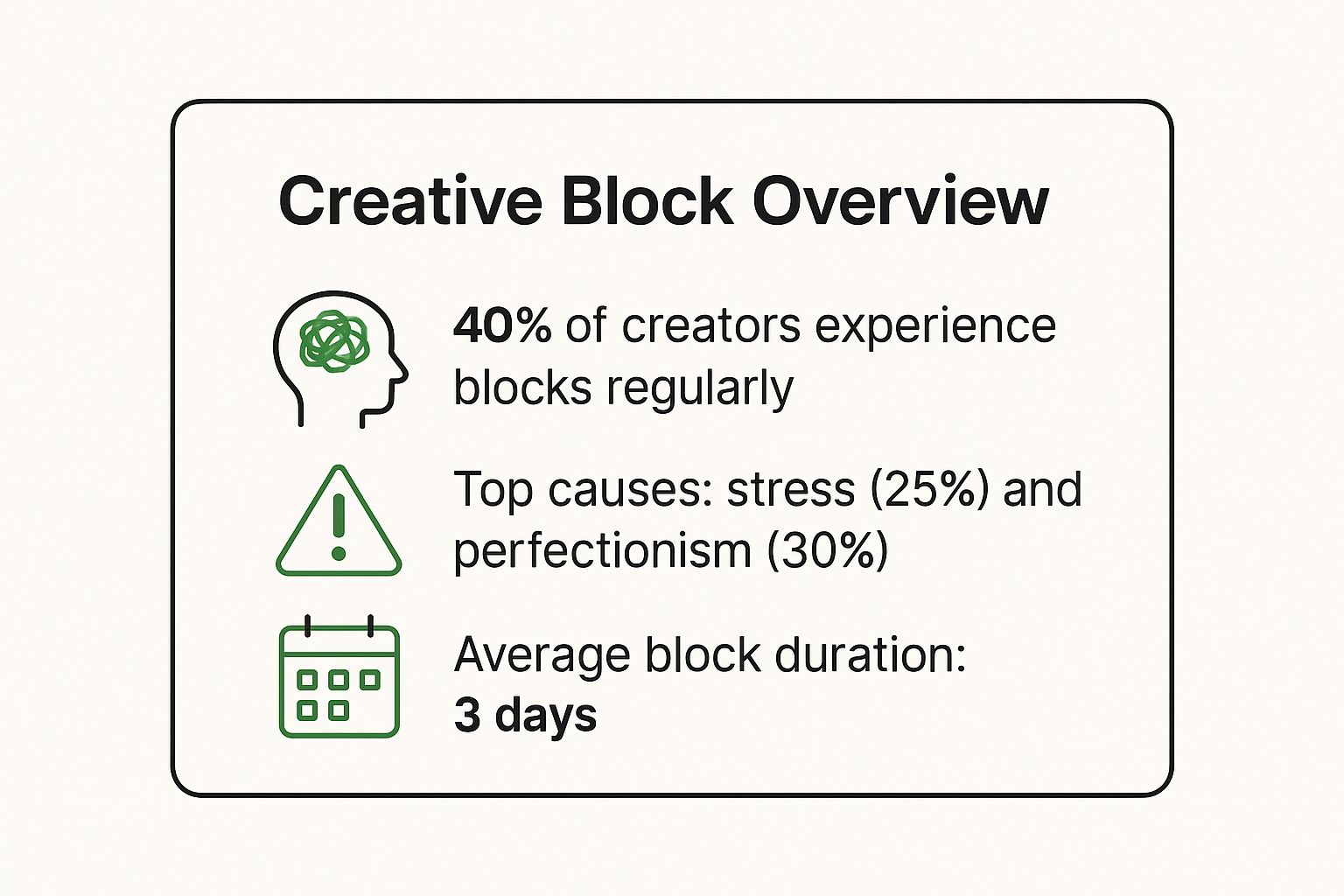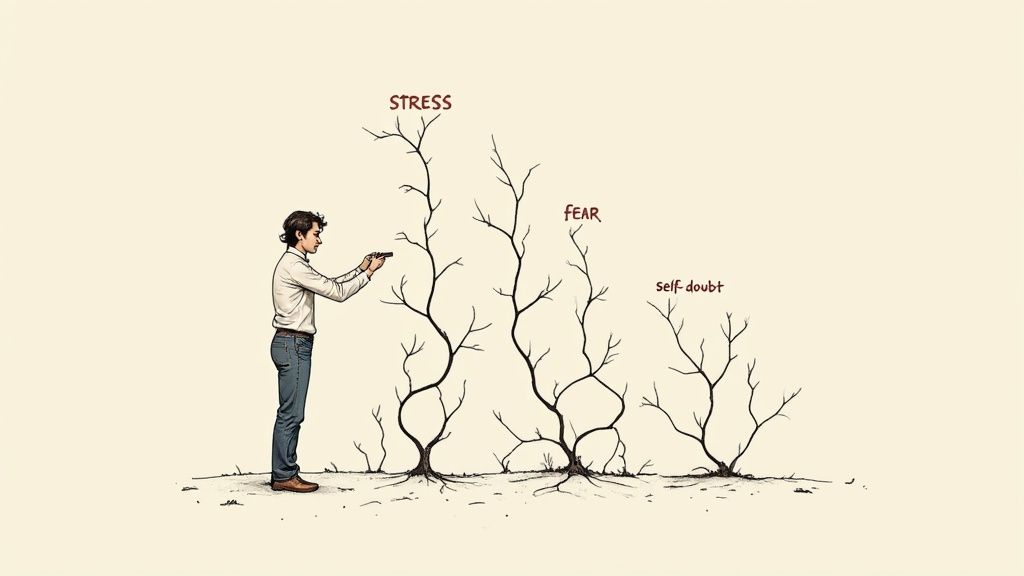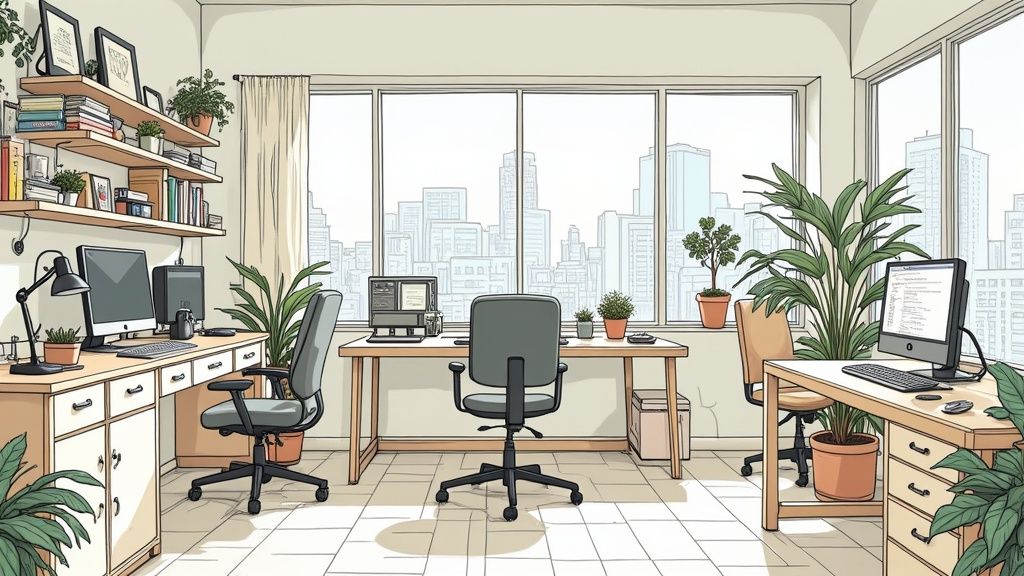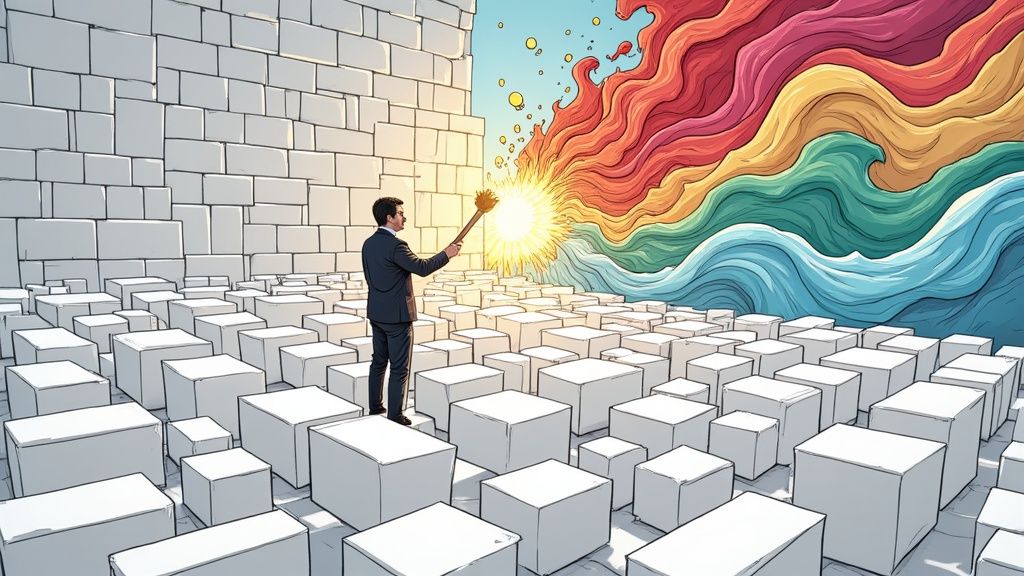How to Overcome Creative Block: Tips to Reignite Your Creativity
Staring at a blank page, feeling that familiar dread creep in? We've all been there. That mental wall isn't just a minor annoyance; it’s a real barrier that stops great work in its tracks. It feels unpredictable and completely out of our control.
But what if it wasn't?
The secret to beating creative block isn't waiting around for a lightning bolt of inspiration. It's about building a reliable process that keeps ideas flowing, even on the days you feel completely drained. It's less about magic and more about method.
Why Creative Block Happens and How to Beat It
Let's get one thing straight: creative block is not some mysterious curse. It's a problem with real, identifiable causes. Once you know what’s tripping you up, you can start to fix it.
Most of the time, that "stuck" feeling comes down to one of a few usual suspects:
- You're just plain tired. Creative thinking takes a lot of mental horsepower. If you're running on empty from constant pressure and not enough rest, your brain simply doesn't have the fuel to innovate.
- You're scared of not being perfect. This is a big one. The pressure to write the perfect sentence or design the perfect graphic right out of the gate is paralyzing. It kills ideas before they even have a chance to breathe.
- You're stuck in a rut. Our brains need new things to chew on. If your days are a carbon copy of each other—same office, same websites, same routine—your creative well is going to run dry. It’s that simple.
- Your mind is too full. When your brain is cluttered with deadlines, a mountain of a to-do list, and personal stress, there’s just no room for creative thought to emerge.
Recognizing these triggers is half the battle. You’re not "out of ideas"—you're probably just exhausted, overwhelmed, or in need of a change of scenery.
The Real Cost of Getting Stuck
This isn't just about feeling frustrated. Creative block has a very real impact on your bottom line. All that lost productivity adds up. In fact, data shows it costs creative professionals about 3 to 5 hours every week.
For an individual, that can translate to an estimated $13,000 in lost annual revenue. Suddenly, that "minor" writer's block feels a lot more significant, doesn't it? You can read more about the financial impact of creative block to see the full breakdown.
This image really drives home how common this is and what the biggest culprits are.

As you can see, you're definitely not alone in this fight. Perfectionism and stress are the true enemies of creative flow for so many of us.
Sometimes, the first step is just figuring out why you feel stuck. The table below is a quick-start guide to help you pinpoint the cause and find a strategy that actually works.
Common Creative Block Triggers and Their Solutions
| Block Trigger | What It Feels Like | Initial Strategy |
|---|---|---|
| Fear & Perfectionism | "Nothing I write is good enough." "I'll just mess it up." | Give yourself permission to create a "terrible" first draft. |
| Burnout & Fatigue | "I'm too tired to even think." "I just don't have the energy." | Step away from the screen. Take a real break—a walk, a nap, anything but work. |
| Lack of New Input | "I'm just rehashing the same old ideas." "I feel uninspired." | Change your environment. Work from a coffee shop, read a book on a new topic, or listen to a different podcast. |
| Overwhelm | "I have too much to do, I can't focus." "My mind is racing." | Do a "brain dump." Write down every single task and worry on a piece of paper to clear your head. |
Think of this table as your diagnostic tool. When you feel that wall go up, a quick check-in here can point you in the right direction instead of leaving you to spin your wheels.
Key Takeaway: You can’t solve creative block with the same mindset that created it. Instead of forcing an idea, focus on changing your state of mind and your process. This guide will provide actionable systems to do just that, turning frustration into consistent, productive output.
Build an Environment for Consistent Creativity

If you’re waiting around for random flashes of inspiration, you’re going to be waiting a long time. It’s a sure-fire way to kill your momentum. The most productive creatives I know don’t sit around hoping for motivation to strike; they build an environment where ideas are practically invited to show up.
This is all about intentionally designing your physical and mental space to fend off creative block before it even has a chance to settle in.
Set Up Your Physical Space
Your brain is a creature of habit. It loves cues. When you consistently work in the same dedicated spot, you’re basically training your mind to switch into "create mode" the moment you sit down. It doesn't have to be a whole home office—a specific desk, or even a particular chair, can become your trigger for focus.
The real key is to minimize friction. You want to remove anything that can pull you out of that precious flow state.
- Tidy up your desk. A cluttered space often leads to a cluttered mind. Taking a minute to clear the decks removes visual noise and helps you think more clearly.
- Silence the pings. Put your phone on silent and, if you can, stick it in another room. Close out all those extra browser tabs and kill the email pop-ups.
- Invest in good headphones. A pair of noise-canceling headphones can be a lifesaver, creating a quiet bubble of focus, even if your house is chaotic.
Structure Your Mental Workspace
Your mental setup is just as critical as your physical one. An unstructured day is a breeding ground for procrastination and decision fatigue—two of the biggest culprits behind creative block.
Instead, create routines that save your mental energy for the actual creative work. I’m a huge fan of time-blocking. This just means scheduling specific, non-negotiable blocks of time in your calendar for deep creative work.
A content creator, for instance, might block off 9 AM to 11 AM every single day for “First Draft Writing.” During that window, that’s the only thing on the agenda. This simple act of scheduling removes the exhausting "what should I work on now?" question and just lets your brain get down to business. It’s incredibly helpful for big projects, like mapping out a full month of posts or diving deep into your https://publora.com/blog/social-media-content-creation strategy.
Here's a powerful little secret: taking 15-minute 'micro-recovery' breaks between work sessions can lead to breakthroughs three times faster for 72% of professionals. This really challenges that old "power through it" mentality.
These short breaks aren’t about being lazy; they’re strategic. Step away from the screen, do some stretches, or just stare out the window for a bit. This mental reset allows you to come back to your work with fresh eyes, which is often exactly what you need to get past a stubborn creative hurdle.
Architect Your Creative Day
A sustainable creative practice is all about rhythm—pairing intense periods of focus with deliberate rest. It’s a marathon, not a sprint.
Here’s a simple structure I’ve seen work wonders:
- Morning Deep Work (90 minutes): Hit your most demanding creative task first thing when your mind is at its sharpest.
- Micro-Recovery (15 minutes): Get up, walk around, and completely unplug from the task.
- Shallow Work (60 minutes): Switch gears to less demanding stuff, like answering emails or organizing files.
- Second Deep Work Session (90 minutes): Jump back into your main creative project or start on a new one.
And sometimes, what you really need is a complete change of scenery. If the daily routine just isn't cutting it, think about planning one of these creative solo retreats. Getting away can do wonders for immersing yourself in your work and sparking new inspiration.
By building a system you can rely on, you turn creativity from a random occurrence into a consistent, daily practice.
Break Through Stagnation with Iteration and Feedback

When you're really stuck, the absolute worst thing you can do is sit around waiting for that one perfect idea to strike. I've been there. Perfectionism is the ultimate creativity killer, trapping you in a frustrating loop of overthinking and getting nothing done.
The best way to shatter that creative wall? Flip your approach completely. Stop thinking and start doing.
My go-to strategy for this is rapid iteration. Instead of pouring all your energy into a single masterpiece from the get-go, just focus on creating a few different versions of your idea. This isn't about making more work for yourself; it's about opening up more possibilities.
Think of it as A/B testing for your own brain. When you produce several variations, you take the pressure off any single one having to be "the one." It's a small mental shift, but it’s incredibly freeing. A huge, scary task suddenly becomes a series of small, easy-to-handle experiments.
Adopt an Experimental Mindset
To make iteration really click, you have to start thinking like a scientist running a bunch of low-stakes experiments. Every version you create—whether it's a headline, a paragraph, or a design concept—is just a hypothesis. The goal isn't to nail it on the first try, but to learn something valuable from each attempt.
Let’s say you’re a writer staring at a blank page, completely blocked on an article intro. You could try writing a few quick versions:
- Version 1: Kick it off with a shocking statistic.
- Version 2: Ask the reader a direct, relatable question.
- Version 3: Tell a quick, personal story.
None of them has to be polished. The simple act of creating them builds momentum and gives you actual material to work with, which is infinitely better than staring at a blinking cursor. You’ve instantly moved from being paralyzed to actively solving the problem.
This isn’t just a trick for solo creators; it's a proven strategy used at a massive scale. Think about the global advertising industry. Major research shows that testing huge numbers of creative variations is how they find what truly connects with people. One report analyzed an incredible 1.1 million video creative variations across 1,300 apps. You can read more about these massive creative optimization trends to see just how powerful this is.
Key Insight: When you feel blocked, don't try to solve the entire problem at once. Instead, create multiple small solutions (iterations) and let feedback show you the way forward. Action creates clarity.
Gather Feedback to Guide Your Next Move
Okay, so you have a few different versions. What's next? It's time to get some feedback. This doesn't need to be some big, formal review process.
Just share your options with someone you trust—a colleague, a friend, or even a small, friendly audience on social media. A simple "Hey, which one of these grabs you more?" is often all you need.
The feedback you get isn't a grade on your talent; it's just data. It tells you what's landing, what's confusing, and what’s falling flat. This information is pure gold because it takes the guesswork out of your process. That vague, frustrating feeling of being "stuck" transforms into a clear, objective path forward, showing you exactly what to tweak for your next attempt.
Defeat the Fear That Is Killing Your Creativity
It’s not always a lack of ideas or sheer exhaustion that brings on a creative block. More often than not, the real culprit is a single, powerful emotion: fear.
It’s that little voice in your head, the one that whispers, "What if they hate it?" or "This just isn't good enough." This fear—of judgment, failure, or not being perfect—can freeze even the most experienced professionals in their tracks. It stops brilliant work before it ever has a chance to begin.
The trick isn't to become fearless. That's impossible. It's about learning to create despite the fear. The first step is to draw a firm line in the sand, emotionally separating your self-worth from what you create. A project that falls flat or a clunky first draft isn't a verdict on you as a person. It's just a data point—a necessary part of the messy, wonderful creative process.
Separate Yourself from Your Work
Your job is to produce the work, not to be the work. Internalizing this mindset shift is incredibly freeing. It gives you the permission you need to play, to make mistakes, and, most importantly, to create something that's simply "good enough" to get the ball rolling. Once you have momentum, you're halfway to beating the block.
Think about a social media manager trying to write the perfect Instagram caption. They could stare at a blank screen for an hour, paralyzed by the pressure. Or, they could switch their goal from "perfection" to "progress" and quickly draft three different options. This tiny action gets them unstuck and moving forward. Consistency is key here, and if you're looking for ways to build that rhythm, our guide on how to schedule Instagram posts is a great place to start.
Embrace Smart Creative Risks
Here's something I've seen time and again: creative people and the companies they work for are often terrified of taking risks. This cautious approach feels safe, but it’s actually a huge barrier to doing anything truly innovative.
A recent State of Creativity study really drove this home. It found that while only 13% of companies are considered risk-friendly, a whopping 29% are highly risk-averse. This fosters a culture where safe, predictable ideas get the green light over ones that could actually be game-changers. You can dig into more insights from the study, including how risk-taking brands see four times higher profit margins, in the full State of Creativity report.
Key Takeaway: We're not talking about reckless gambles here. The goal is to take smart, calculated creative risks. When you reframe failure as discovery instead of a dead end, you give yourself the psychological safety needed to experiment.
So, how do you put this into practice? Start small.
Challenge yourself to try one new thing each week that pushes you just a little bit outside your comfort zone.
- Maybe you use an unexpected color palette in a design.
- Or you could kick off an article with a bold, provocative statement.
- You could even pitch that one marketing idea that feels a bit wild and unconventional.
Each small risk you take is like a rep at the gym for your creative confidence. It proves that the catastrophic fallout you imagined almost never happens. This is how you slowly and surely dismantle the fear that’s holding your best work hostage.
Use Smart Tools and Techniques to Spark New Ideas

Let's be honest, sometimes your own brain just isn't cooperating. When you feel like you've completely run out of ideas, the right tool or a fresh technique can give you the jump-start you need. It’s like having a creative partner on call.
This isn’t about letting a tool do the work for you. It’s about augmenting your own creativity. Think of it as a collaborator that can show you a dozen new angles in a matter of minutes, breaking you out of that mental rut.
Reimagine Classic Brainstorming Methods
Before you jump straight to the latest app, let's revisit an old-school classic: mind mapping. It’s so much more effective than a simple, linear list. You start with your main topic in the center of a page and draw branches out for every related idea, question, or theme that comes to mind.
Say you're stuck on a blog post about "healthy eating." Your core branches could be "meal prep," "common myths," and "budget-friendly foods." From there, you can branch out even further. This visual web helps you see connections you’d otherwise miss, often revealing entire content pillars you hadn't considered.
Key Takeaway: The point here isn't to land on the perfect idea right away. It's to generate a ton of possibilities. The more raw material you have, the more you have to work with, turning that intimidating blank page into a field of potential.
Use AI as Your Creative Sparring Partner
AI has quickly become a powerful ally in the fight against creative block. Modern AI tools are fantastic for exploring concepts at high speed, but the trick is to treat them as a brainstorming assistant, not a ghostwriter.
For example, if I'm stuck on an article's opening, I might ask an AI tool to:
- Generate 10 surprising statistics about social media marketing.
- List five common misconceptions about personal finance for freelancers.
- Write three different introductory hooks for an article about overcoming creative block.
This gives me immediate, external input that helps me break free from my own repetitive thoughts. In the same way, a designer could use an image generator with prompts like, "logo concept for a sustainable coffee brand, minimalist, earthy tones" to get instant visual starting points.
Once you have a backlog of great ideas, you'll need a way to manage them. You'll find our guide on the best social media management tools incredibly helpful for that.
The Impact of Modern Creative Tools
Using technology strategically can make a huge difference. AI collaboration tools like DALL-E have become a go-to for many creatives. In fact, some data suggests these tools can help resolve 41% of creative blocks in just 15 minutes.
Even so, it's worth noting that 72% of artists are still hesitant to adopt AI, citing concerns about authenticity. This really highlights the need to use these tools ethically and as a supplement to, not a replacement for, your own unique creativity. You can read more about how artists view AI on Inkbot Design's blog.
Still Have Questions About Creative Block?
Even with a full toolkit of strategies, hitting a creative wall can leave you with some nagging questions. Let's tackle a few of the most common ones I hear from fellow creators trying to find their way out of a slump.
How Long Does This Awful Feeling Last?
Honestly, there's no set timeline. A creative block could be a frustrating afternoon affair, or it could drag on for weeks—sometimes even months in really tough cases.
What really determines the length is the root cause. If you're just mentally tired, a good night's sleep might be all you need. But if the block is a symptom of deep-seated burnout, it's going to take more than a nap to fix. The trick is to be proactive. Don't just sit there and wait for inspiration to strike. Getting hands-on with the strategies we've talked about, like switching up your workspace or talking it out with a colleague, is the quickest way to get things moving again.
Is Creative Block Just Another Word for Burnout?
That's a great question, and the short answer is no—but they're definitely related. It's best to think of a creative block as a symptom of burnout, but not the same thing.
Burnout is a much bigger beast. It's that all-encompassing feeling of physical, mental, and emotional exhaustion from being under too much stress for too long. A creative block, on the other hand, is laser-focused on your inability to come up with new ideas or get the work done.
You can have a creative block without being burned out (sometimes you just need a fresh perspective!). But if you are burnt out, a creative block is pretty much a given. If burnout is the real culprit, prioritizing genuine rest is the only way to truly solve the problem.
Do I Really Need to Take a Long Break to Fix This?
Not at all! While whisking yourself away on a solo retreat sounds amazing, it's not always practical—or even necessary. Plenty of powerful fixes can be slotted right into your regular workday.
You don't have to take a week off to feel a difference. Small, consistent actions are often just as good at resetting your creative mind.
Here are a few quick things you can try right now:
- Take a 'micro-recovery' break. Stepping away from your screen for just 15 minutes can work wonders.
- Change gears. If the words aren't coming, spend an hour organizing your files or clearing out your inbox.
- Play with a brainstorming tool. A quick 10-minute session with a mind-mapping app or an AI idea generator can give you the outside nudge you need.
- Just go for a walk. A short stroll gets you moving and physically removes you from the source of your frustration. You'd be surprised how often a solution pops into your head the moment you step back inside.
These little resets are so effective because they shatter that frustrating cycle of staring at a blank page. They introduce a bit of novelty and movement, which is often exactly what your brain needs to get unstuck and find its flow again.
Ready to conquer creative block and streamline your entire content workflow? Publora gives you the tools to plan, create, and schedule your social media content from a single, intuitive dashboard. With our AI-powered idea generator and smart scheduler, you'll save over 10 hours a week and never stare at a blank calendar again. Start your free 14-day trial and see the difference.
